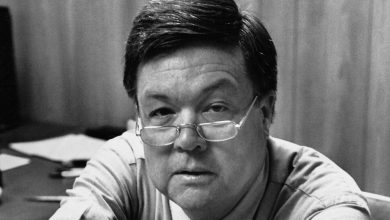Pierre Lacotte, Choreographer Who Aided a Defection, Dies at 91

Pierre Lacotte, a French choreographer and dance historian who was known for researching and restaging 19th-century ballets — and also for playing a modest role in helping the dancer Rudolf Nureyev defect from the Soviet Union in 1961, which made headlines around the world — died on Monday in La Seyne-sur-Mer, in southern France. He was 91.
The National Opera of Paris posted news of his death on its website. His wife, the dancer Ghislaine Thesmar, told Agence France-Presse that the cause was sepsis from an infected cut.
Mr. Lacotte had a long career in dance; just two years ago, at age 89, he choreographed and designed an adaptation of the 1830 Stendhal novel “The Red and the Black” for the Paris Opera Ballet. But the real-life drama in which he was involved more than 60 years ago brought him almost as much attention as his dance works.
Mr. Nureyev was 23 and already generating buzz for his powerful dancing when he went to Paris in 1961 with the Kirov Ballet of Leningrad. At a reception after the Kirov’s opening performance on May 16 (in which Mr. Nureyev did not perform), the Soviet dancers were keeping to themselves, as were the French dancers who had been invited, Mr. Lacotte among them. But eventually, Mr. Nureyev began inching across the divide.
“This one is completely different,” Mr. Lacotte remarked to friends, according to Julie Kavanagh’s “Nureyev: The Life” (2007). “You can see from the way he is looking around that he’s interested in everything: He’s talking with his eyes.”
Mr. Nureyev did not speak French, but both men spoke English. The two became friends, and Mr. Nureyev, in defiance of his K.G.B. watchdogs, went on excursions around Paris with Mr. Lacotte and other French dancers. And when Mr. Nureyev made his Paris debut in a performance on May 19, “he was like a tiger,” Mr. Lacotte said.
“People screamed,” he recalled. “I’ve seen hundreds of Rudolf’s performances, and never did he dance like that.”
Perhaps Mr. Nureyev’s disregard for authority — he would sometimes jump off the troupe’s official tour bus and explore Paris himself — led the Soviets to decide that instead of accompanying the Kirov on the next leg of its tour, to England, he should return to Moscow. He was separated from the other dancers as they prepared to depart at Le Bourget Airport, leading to a dramatic confrontation captured in Ms. Kavanagh’s book and in the 2018 movie made from it, “The White Crow.”
Mr. Lacotte and some of the other friends Mr. Nureyev had made in France accompanied him to the airport, and when Mr. Nureyev realized he was being sent back to the Soviet Union, he implored them to help. “If I leave here I will not return to Europe anymore,” Mr. Lacotte recalled him saying in a 2021 interview with the Spanish news agency EFE.
Peter Watson, in his 1994 biography, “Nureyev,” said Mr. Nureyev implored Mr. Lacotte: “For pity’s sake save me. I’m going to end up in Siberia.” He is said to have taken out a toy dagger Mr. Lacotte had given him as a gift and added, “If you don’t help me, I’m going to kill myself.”
In any case, Mr. Nureyev’s friends found out the proper procedure for defecting and told Mr. Nureyev what he had to do: He approached two French police officers and asked for asylum. It was a startling moment, coming at the height of the Cold War. Mr. Nureyev became an international star and did not return to the Soviet Union until 1987. He died of AIDS in 1993.
According to Ms. Kavanagh’s book, a document in Mr. Nureyev’s K.G.B. file claimed that Mr. Lacotte was “the main perpetrator of a plan to persuade Rudolf to stay in Paris.” But Mr. Lacotte told her that neither of them had talked about the defection before it actually happened, although Mr. Nureyev had spoken about feeling constricted.
“Rudolf would complain: ‘They’re against me all the time. I can’t say or do what I think,’” Ms. Kavanagh quoted Mr. Lacotte as saying. “But I’d tell him: ‘Listen, as a dancer you need that discipline. Remember that you’re here in Paris, and dance like a god.’”
Pierre Lacotte was born on April 4, 1932, in Chatou, just outside Paris. When he was a boy, he met the Russian ballerina Lubov Egorova, who had danced with the Imperial Ballet in prerevolutionary Russia and eventually settled in Paris.
She became one of his teachers and, Mr. Lacotte told The New York Sun in 2005, over the years shared with him what she remembered of the ballets of her day and told him that he had the skills and background to carry the memory and the techniques forward. After creating works with pop and jazz artists early in his career, he realized she was right.
“When I was young, I wanted to be a modern choreographer,” Mr. Lacotte said. “I left the Paris Opera Ballet to study in New York with Martha Graham and Peter Gennaro, who did great shows for Broadway. In the 1950s, I made ballets with Sidney Bechet and Charles Aznavour. Every young person wants to live with his generation. But Egorova was right. So now I am known as the man who stages revivals.”
He had started out as a dancer with the Paris Opera Ballet and made his American debut in 1956 with the Metropolitan Opera in New York, partnering with Mary Ellen Moylan in Zachary Solov’s “Soirée.”
“He has a simple and thoroughly ingratiating presence,” John Martin wrote in a review in The New York Times, “as well as a good sense of what it means to be onstage.”
The year before his American debut, Mr. Lacotte had formed his own company, Les Ballets de la Tour Eiffel, hoping to further his interest in choreographing. After an ankle injury, he retired from dancing and concentrated on choreography, eventually specializing in reconstructing ballets of the past that had largely been lost.
One notable example, first staged in 1972, was “La Sylphide” — not the Danish version created in 1836 by August Bournonville, which was still familiar to audiences, but Filippo Taglioni’s original 1832 version. Mr. Lacotte worked from Taglioni’s notebooks to try to recapture that early incarnation.
It became one of his signature works. In 1981, when his “Sylphide” had its United States premiere in New York in a production by the Boston Ballet, Mr. Nureyev and Ms. Thesmar, Mr. Lacotte’s wife, were both in the cast. Anna Kisselgoff, reviewing in The Times, called it “a fascinating production.”
A full list of survivors in addition to his wife was not immediately available.
Another reconstruction was his version of “The Pharaoh’s Daughter,” an 1862 ballet by Marius Petipa. The Bolshoi Ballet brought it to the Metropolitan Opera House in 2005.
With that and his other reconstructions, Mr. Lacotte acknowledged, it wasn’t possible to fully recreate what 19th-century audiences saw; there were a fair number of his own ideas in any given piece.
“Sometimes, you must make hard choices — but always with knowledge, admiration and respect,” he told The Sun. “To please the public and the dancers, you must look at the past and live in this century.”




